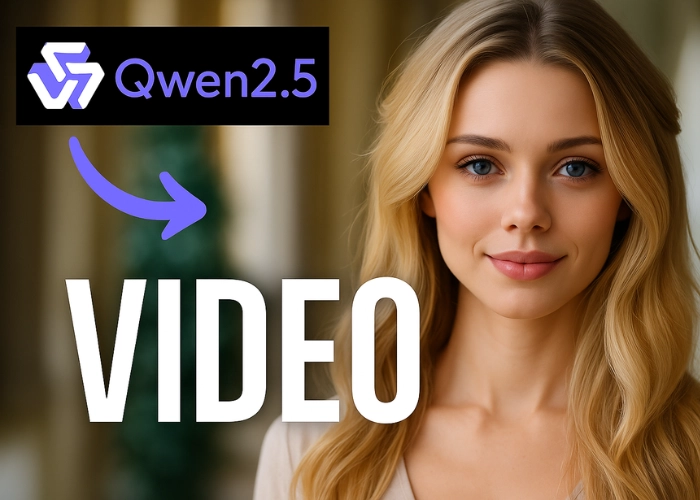Searching for a free AI video generator that works in your browser and taps enterprise-grade technology? Alibaba Cloud’s Qwen Chat, paired with the open-source Tongyi Wanxiang (Wan2.1) text-to-video engine, lets you turn natural-language ideas into polished clips—no GPU or subscription needed. This 2025 deep-dive explains where Qwen fits, how Wan2.1 creates the pixels, why benchmarks rank it top-tier, and what prompt tactics unlock the best cinematic results.

Can You Really Generate Video inside Qwen Chat?
Yes—when the experimental Video Generation toggle is live. The flow is as simple as chatting:
- Open chat.qwen.ai, sign in, and switch to Video mode.
- Write a descriptive prompt (e.g. “4-second dolly-zoom through a neon Tokyo alley, cinematic 24 fps”).
- Hit Generate; Qwen 3 parses intent, calls the Wanxiang backend, and returns an MP4.
Reality check: public availability is sporadic—buttons vanish, quality swings, and rate limits trigger errors. Treat it as a beta preview, not a production pipeline.
Architecture Breakdown: Qwen Plans, Wanxiang Produces
Qwen LLMs (Qwen 2.5, Qwen 3) are conversation brains. They interpret your text, manage session context, and format an API request. The Wanxiang ≤ Wan2.1 family is the generator: a diffusion-based video model that synthesises every frame.
Wan2.1 Feature Highlights
- Open-source Apache 2.0 core (1.3 B & 7 B params) – free to fine-tune or self-host.
- 1080 p output up to 4-6 s; coherent objects, realistic physics, stable lighting.
- Multilingual text rendering (EN + ZH) inside scenes—rare among open models.
- Three pipelines: Text-to-Video (T2V), Image-to-Video (I2V), First-Last-Frame (FLF2V).
- Fast inference: 1.3 B variant runs on an 8 GB RTX 3050 (~90 s clip).
Benchmark Proof: VBench & Beyond
| Model (open-source) | VBench Score* (↑) | License | Notable Edge |
|---|---|---|---|
| Wan2.1-7B | 85.6 % | Apache 2.0 | Best open model overall |
| Pika 1.0 | 79.4 % | Closed | Fine style diversity |
| Stable Video Diffusion | 77.8 % | Creative ML OpenRAIL-M | Strong community mods |
*VBench 2025-03 full-set; higher = better temporal & visual fidelity.
Wan2.1’s score edges out some closed contenders (OpenAI Sora preview ≈ 84 %, Google Veo ≈ 82 %) while remaining fully downloadable—crucial for research and indie creators.
Getting Reliable Clips Today (Work-Arounds)
- Official Wanxiang Web Demo – Alibaba’s hosted playground usually stays online even when Qwen’s button is disabled. Search “Tongyi Wanxiang video demo”. Free credits refresh monthly.
- Run Locally – pull
Wan-Video/Wan2.1on GitHub or Hugging Face. Needs Python 3.11, PyTorch 2.1, and an 8 GB+ GPU for the 1.3 B checkpoint. - Third-party UIs – community front-ends like ComfyUI & Automatic1111 already integrate Wan2.1 nodes for drag-and-drop workflows.
Prompt Engineering for Stunning AI Video
Wan2.1 follows the “describe scene → render 24 fps” paradigm. Detailed, coherent prompts raise quality and reduce artefacts.
Seven-Slot Prompt Template
| Slot | Fill-in Ideas |
|---|---|
| Subject + Action | “Golden retriever puppy chasing a kite” |
| Environment | “on a sunny beach at sunset” |
| Camera Work | “hand-held close-up, slight shake” / “aerial dolly-zoom” |
| Style / Medium | “hyper-realistic 8 K” / “hand-painted water-color animation” |
| Motion Speed | “slow motion 120 fps then exported 24 fps” |
| Lighting / Mood | “warm golden hour with long shadows” |
| Negative Cues | “no text, no watermark, avoid blur, avoid glitch frames” |
Example Ready-to-Copy Prompts
- “4-second aerial tracking shot of a cyberpunk hover-car weaving between neon skyscrapers, night rain, volumetric lights, 24 fps, cinematic grade, no artifacts.”
- “Macro timelapse of an ice cube melting on a wooden bar top, droplets forming, dramatic close-up, ultra-HD, studio lighting, no logo.”
- “Hand-drawn anime style, a girl releasing lanterns on a riverside during spring festival, gentle panning camera, soft pastel palette, 10 s loop.”
Use Qwen Chat as a Prompt Generator
Qwen’s language talent shines here: ask “Create five detailed text-to-video prompts of sci-fi city flythroughs, include camera moves and lighting tags”. Paste your favourite into Wanxiang for better first-pass output.
Performance, Limits & Best Practices
- Clip Length – Wan2.1 default: 48 frames @ 24 fps (≈ 2 s); community mods push 8–12 s.
- Resolution – up-scale from 720 p→1080 p using built-in ESRGAN node for sharper social media posts.
- Seed Consistency –
--seed 12345reproducibility works in local scripts, not yet exposed in Qwen UI. - Batch Mode – generate 4 variations per seed, then cherry-pick best frames for final edit.
Frequently Asked Questions
Is Wan2.1 suitable for commercial projects?
Yes. The Apache 2.0 licence permits commercial use, redistribution, and fine-tuning. Follow Alibaba Cloud’s API terms if using hosted endpoints.
Does Wan2.1 support audio?
No native sound track. Pair your clip with royalty-free music or generate audio separately with models like Qwen Audio.
How does it compare to OpenAI Sora in realism?
Sora teasers show longer, hyper-real clips but remain closed. Wan2.1’s shorter clips are competitive in sharpness and motion, and you can run it today—no wait-list.
Take-Home Points
- Qwen Chat’s video button is a convenience layer; when it’s offline, the Wanxiang engine is still accessible elsewhere.
- Wan2.1 is the leading open-source text-to-video model, topping VBench and running on consumer GPUs.
- Prompt detail equals quality; leverage Qwen LLM to draft rich, coherent scene descriptions.
- For production, use the stable Wanxiang web demo or self-host the open weights for full control and batching.
Ready to create? Draft a cinematic prompt in Qwen Chat, copy it into the Wanxiang demo, and watch your words morph into motion—free, fast, and under your creative control.
